Investigation of a Solar-Powered Evaporative Cooling System under Tunisian Climate
Abstract
:1. Introduction
2. Suitability of the Evaporative Cooling Process for Tunisian Regions
3. System Description and Modeling
3.1. Mass Balance
3.2. Energy Balance
3.3. Numerical Simulation
3.3.1. Effect of Dry-Bulb Temperature on the Wet Air’s Relative Humidity
- (i)
- The output air’s relative humidity depends mainly on the input air’s relative humidity when varying the dry-bulb temperature but keeping the wet-bulb temperature constant.
- (ii)
- In cases (a) and (b), the wet-bulb temperature was kept constant while the dry air’s relative humidity was doubled. The wet air’s relative humidity increased when increasing the dry-bulb temperature until it achieved a maximum value of about 28% in case (a) and 37.5% in case (b). When doubling the value of the dry air’s relative humidity, the maximum value for the wet air’s relative humidity rose by about 40%.
- (iii)
- In cases (a) and (c), the dry air’s relative humidity was kept constant while the wet-bulb temperature increased by about 20%. Thus, the wet air’s relative humidity increased with increasing dry-bulb temperature until it achieved a maximum value of about 28% in case (a) and 24% in case (c). A rise in the wet-bulb temperature by approximately 20% leads to a roughly 14% decrease in the maximum value of the wet air’s relative humidity.

3.3.2. Effect of Dry-Bulb Temperature on the Enthalpies of the Air and Water
3.3.3. Effect of the Dry Air’s Temperature on the Mass of the Added Water
- (i)
- The added water depends strongly on the input dry air’s temperature, although the flow rate for the water is much less than for the air.
- (ii)
- For a constant dry-bulb temperature and relative humidity, a rise in the wet-bulb temperature leads to a decrease in the mass of water that needs to be added.
- (iii)
- For φ1 = 10% and T2 = 20 °C, the maximum value for the water to be added is about 9 g/kgda, and it is achieved at T1 = 42 °C. For φ1 = 10% and T2 = 22 °C, meanwhile, the maximum amount of added water is the same (9 g/kgda), but it is achieved for T1 = 44 °C.
- (iv)
- For φ1 = 10% and T2 = 24 °C, the maximum value of the added water is about 11 g/kgda, and it is achieved for T1 = 50 °C.
- (v)
- It seems that every (T1, φ1) pair for the dry air corresponds to an optimal (T2, φ2) pair for the wet air.
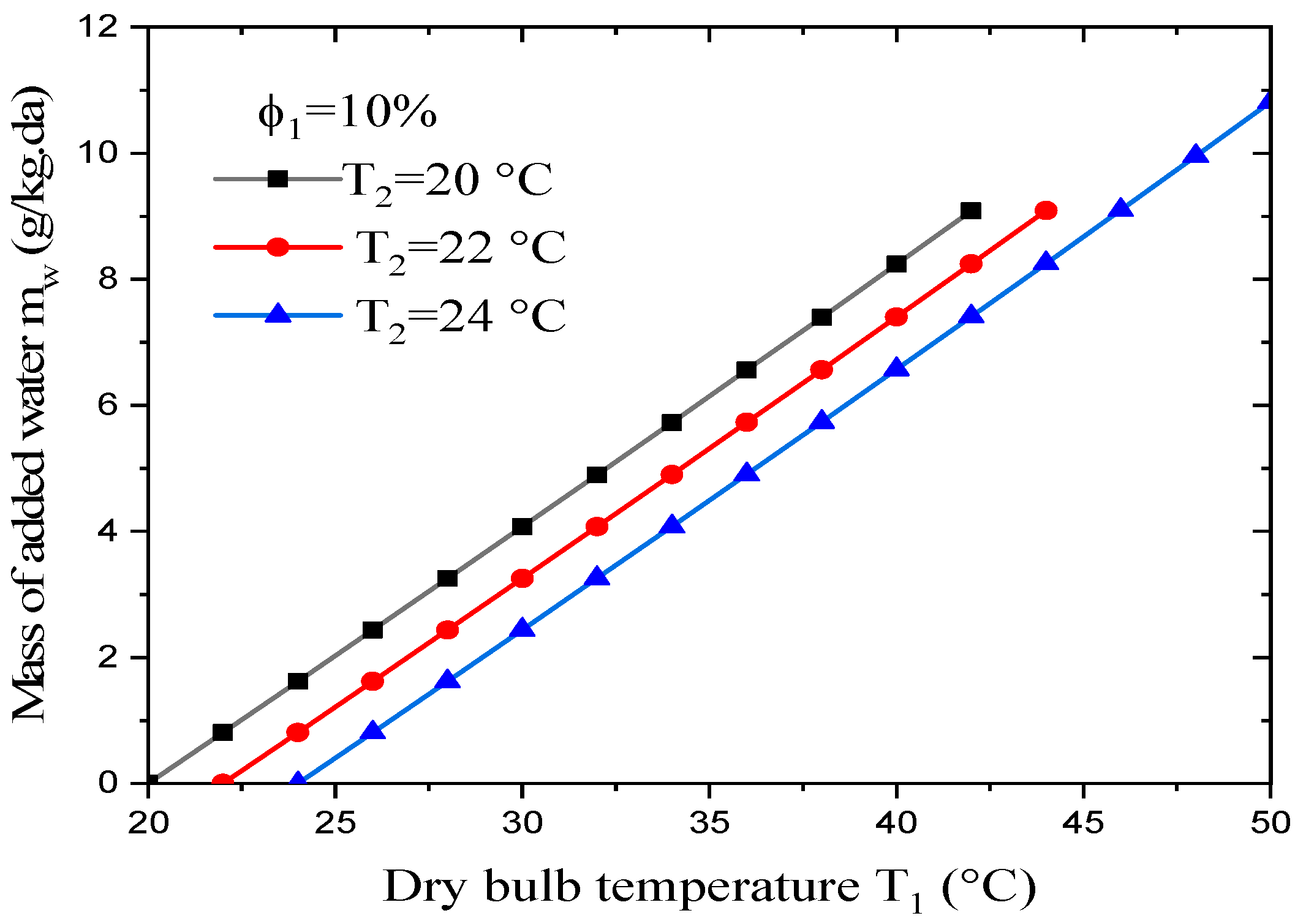
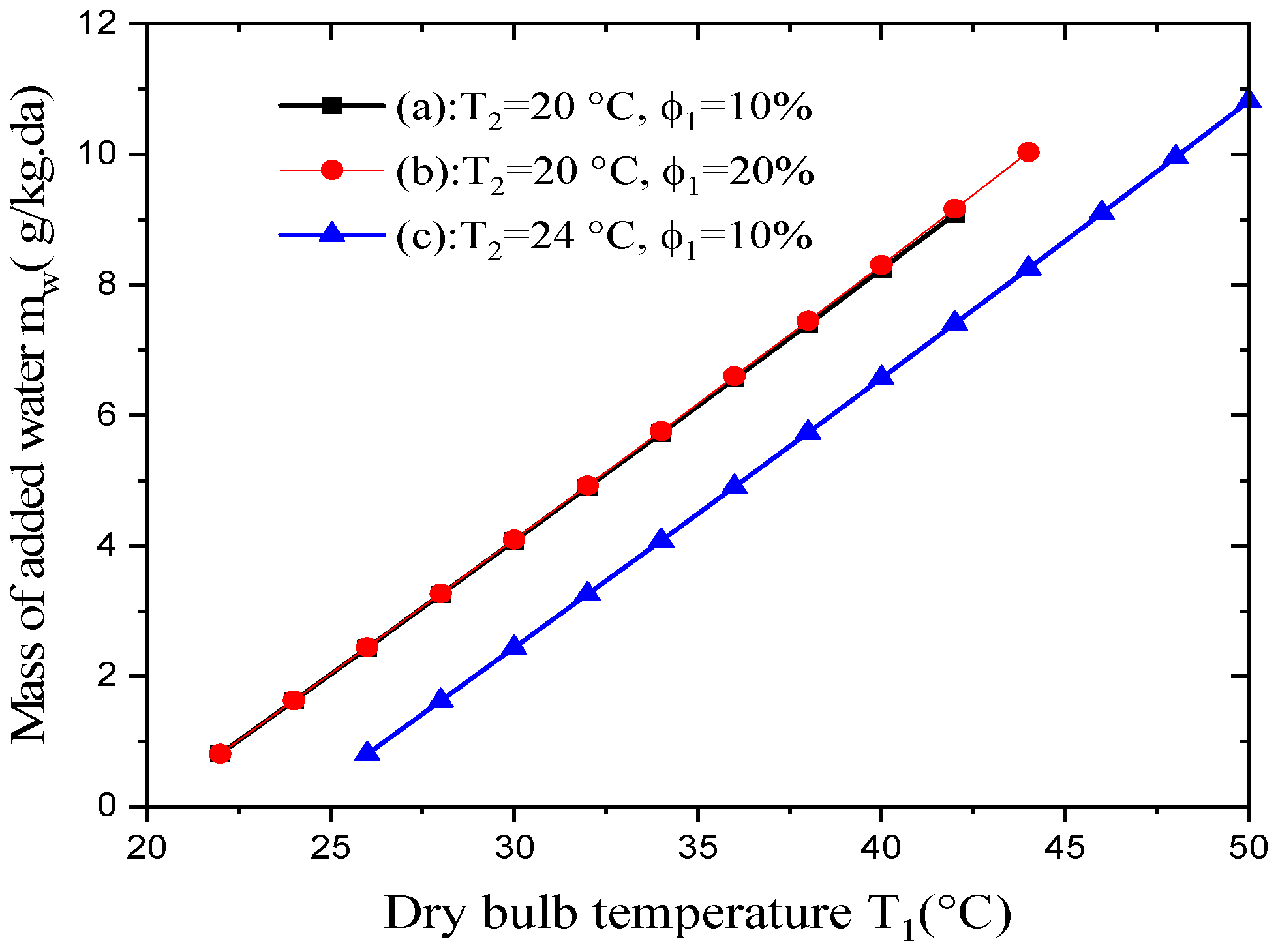
3.3.4. Effect of the Dry Air’s Relative Humidity on the Mass of the Added Water
- (i)
- For a constant dry-bulb temperature T1 and constant wet-bulb temperature T2, the mass of the added water was less sensitive to increases in the dry air’s humidity φ1.
- (ii)
- For a constant relative humidity for the wet air and a constant wet-bulb temperature, any rise in the dry-bulb temperature leads to an increase in the mass of the added water, because more water is needed to humidify the dry air.
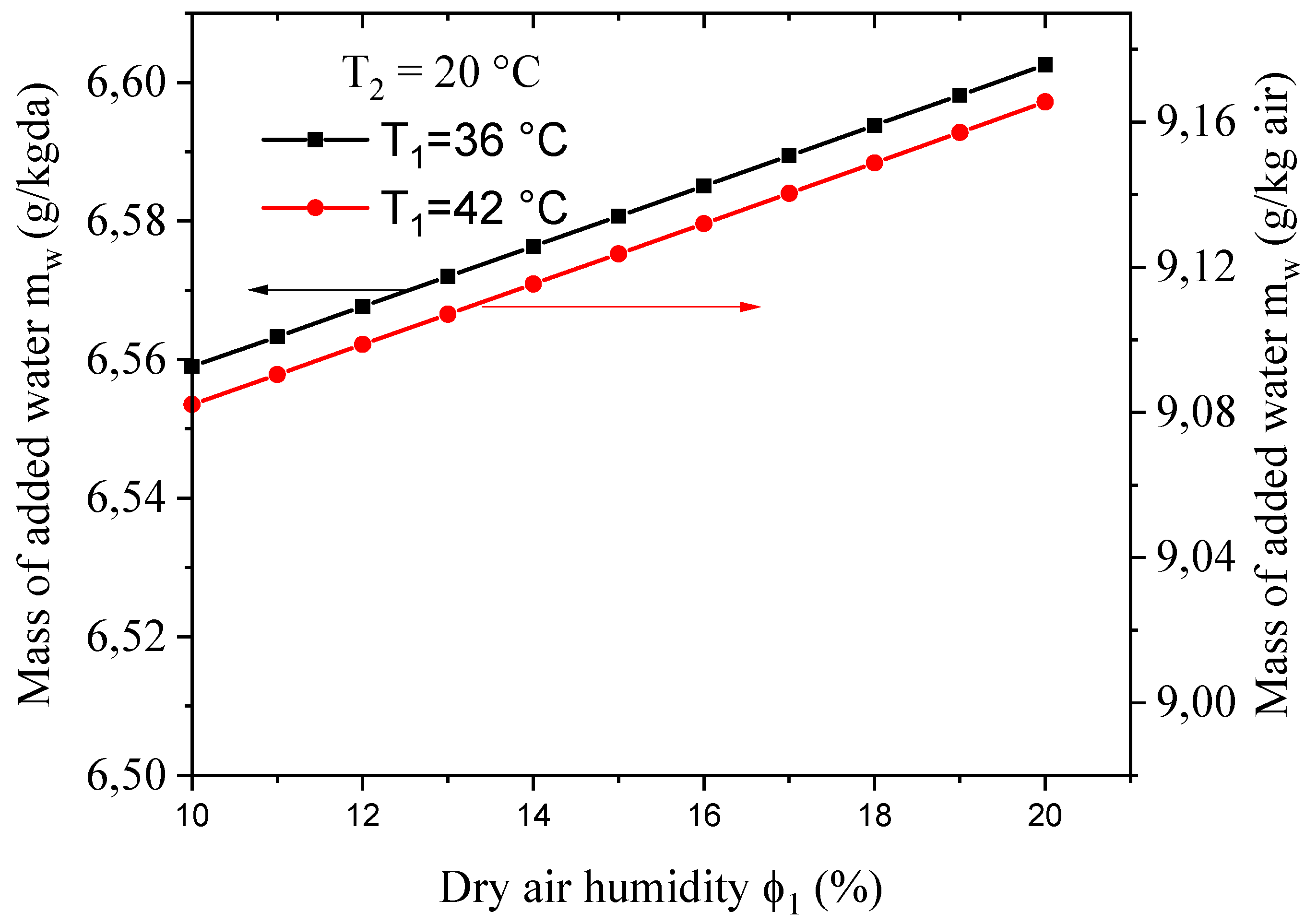
3.3.5. Effect of the Dry-Bulb Temperature on the Evaporative Cooler’s Efficiency
- (i)
- For a desired wet-bulb temperature T2, an increase in the dry-bulb temperature leads to an increase in the evaporative cooler’s efficiency.
- (ii)
- At a constant dry-bulb temperature and desired wet-bulb temperature, an increase in the dry air’s relative humidity leads to an increase in the evaporative cooler’s efficiency.
- (iii)
- For a desired wet-bulb temperature, the evaporative cooler reaches its maximum efficiency (about 94%) when the dry air’s relative humidity is low and the dry-bulb temperature is maximal, while it reaches its minimum efficiency (about 90%) when the dry air’s relative humidity is high and the dry-bulb temperature is low.
- (i)
- At constant relative humidity for the dry air, a rise in the dry-bulb temperature leads to an increase in the evaporative cooler’s efficiency.
- (ii)
- With the dry-bulb temperature and the dry air’s relative humidity kept constant, a rise in the wet-bulb temperature leads to a decrease in the evaporative cooler’s efficiency.
- (iii)
- For a preferred wet-bulb temperature, the evaporative cooler reaches its maximum efficiency (about 98%) with a high wet-bulb depression (WBD), while it reaches its minimum efficiency (about 96%) for a low wet-bulb depression (WBD).
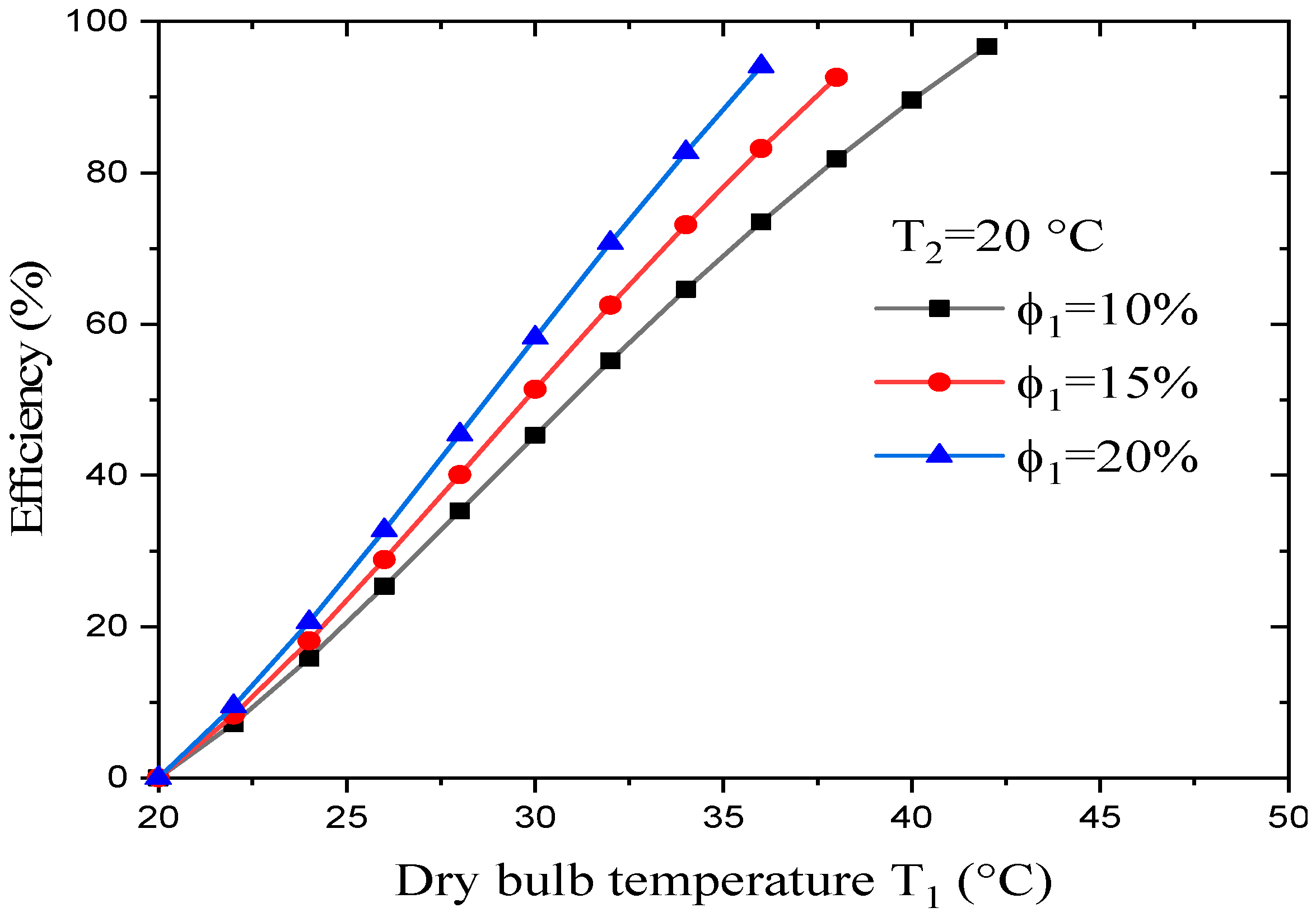
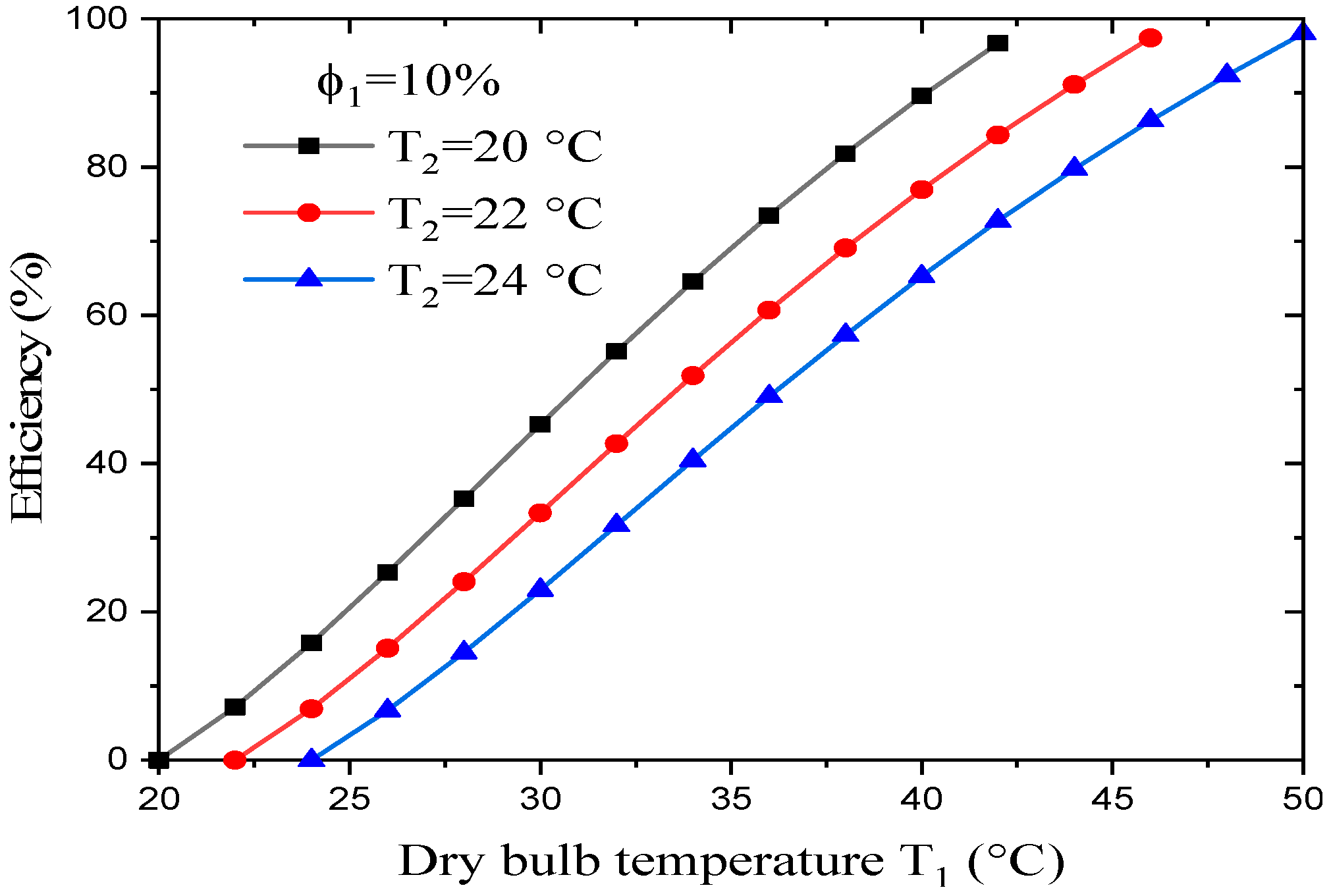
3.3.6. Effect of the Dry Air’s Relative Humidity on the Evaporative Cooler’s Efficiency
- (i)
- At a constant relative humidity for the dry air and the desired wet-bulb temperature, the evaporative cooler’s efficiency increased along with an increasing dry-bulb temperature. This efficiency was maximized for a critical pair of input parameters (T1, φ1).
- (ii)
- At a constant desired wet-bulb temperature and dry-bulb temperature, the variation in the evaporative cooler’s efficiency according to the dry air’s relative humidity was not linear. Indeed, for the pair (T1 = 42 °C; T2 = 20 °C), a 10% rise in the dry air’s relative humidity φ1 leads to an increase in the evaporative cooler’s efficiency of about 25%. For the pair (T1 = 36 °C; T2 = 20 °C), however, a rise in the dry air’s relative humidity φ1 of about 20% leads to an increase in the evaporative cooler’s efficiency of about 40%.
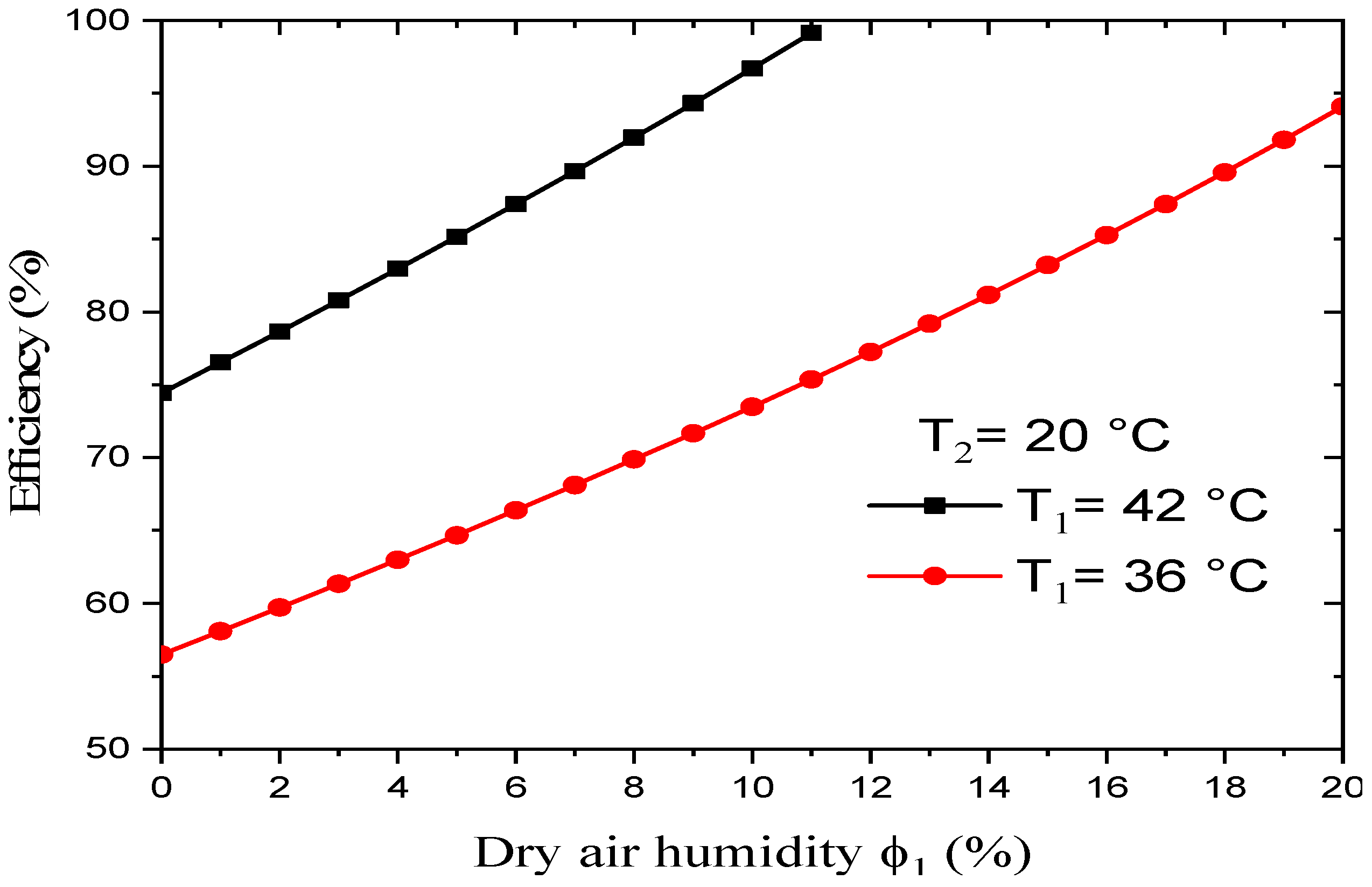
4. Experimental Investigation
4.1. Experimental Set-Up
4.2. Humidification Study
4.3. Measuring Instruments
- -
- Float water flow meter that can measure water flow from 0 up to 50 L/min. Hygrometer which measures both temperature and relative humidity.
- -
- OMRON E5AW type temperature display controller.
- -
- TDL (Tegnologic) type temperature displays.
- -
- Thermocouple: Type K in nature (Chromelle-Allumelle).
- -
- Pt100 type thermistors.
- -
- Vane probe type vane to measure the air flow.
- -
- An “HP Agilent Data Logger” type acquisition channel for the acquisition and data processing.
4.4. Tests and Experimentation
5. Conclusions
Author Contributions
Funding
Institutional Review Board Statement
Informed Consent Statement
Data Availability Statement
Conflicts of Interest
References
- World Energy Council. World Energy Resources 2016. Available online: https://www.worldenergy.org/assets/images/imported/2016/10/World-Energy-Resources-Full-report (accessed on 3 October 2016).
- International Energy Agency. Available online: https://www.iea.org/publications/ (accessed on 12 August 2019).
- Tang, J.; Ni, H.; Peng, R.L.; Wang, N.; Zuo, L. A review on energy conversion using hybrid photovoltaic and thermoelectric systems. J. Power Sources 2023, 562, 232785. [Google Scholar] [CrossRef]
- Kuboth, S.; Heberle, F.; König-Haagen, A.; Brüggemann, D. Economic model predictive control of combined thermal and electric residential building energy systems. Appl. Energy 2019, 240, 372–385. [Google Scholar] [CrossRef]
- Shukhobodskiy, A.A.; Colantuono, G. RED WoLF: Combining a battery and thermal energy reservoirs as a hybrid storage system. Appl. Energy 2020, 274, 115209. [Google Scholar] [CrossRef]
- Baniasadi, A.; Habibi, D.; Al-Saedi, W.; Masoum, M.A.S.; Dasa, C.K.; Mousavia, N. Optimal sizing design and operation of electrical and thermal energy storage systems in smart buildings. J. Energy Storage 2020, 28, 101186. [Google Scholar] [CrossRef]
- Moreno-Munoz, A. Nanogrids, Microgrids, and the Internet of Things (IoT): Towards the Digital Energy Network. Energies 2019, 12, 3878. [Google Scholar] [CrossRef]
- Hwang, Y.; Radermacher, R.; Alili, A.A.; Kubo, I. Review of Solar Cooling Technologies. HVACR Res. 2008, 14, 507–528. [Google Scholar] [CrossRef]
- Jan, A.; Kuhn, A.; Petersan, S.; Zieglar, F. Development and Progress in Solar Cooling Technologies with Sorption System. Chem. Ing. Tech. 2011, 83, 1853–1863. [Google Scholar] [CrossRef]
- Ghafoor, A.; Munir, A. Worldwide Overview of Solar Thermal Cooling Technologies. Renew. Sustain. Energy Rev. 2015, 43, 763–774. [Google Scholar] [CrossRef]
- Elmaaref, M.M. Solar Thermoelectric Cooling Technology. In Proceedings of the 3rd International Conference on Energy Engineering, Aswan, Egypt, 28–30 December 2015; pp. 1–8. [Google Scholar]
- Alazazmeh, A.J.; Mokheimer, E.M. Review of Solar Cooling Technologies. J. Appl. Mech. Eng. 2015, 4, 1–15. [Google Scholar] [CrossRef]
- Usman, M.; Ali, Q.S.; Bilal, M. Assessment of Solar Cooling Technologies using the Analytical Hierarchical Process. World J. Eng. 2017, 14, 84–90. [Google Scholar] [CrossRef]
- Ghatol, S.; Rajput, T. Hybrid Solar Desiccant Cooling System. International. J. Eng. Sci. Res. Technol. 2017, 6, 569–575. [Google Scholar] [CrossRef]
- Ajib, S.; Alahmer, A. Solar Cooling Technologies. In Energy Conversion—Current Technologies and Future Trends; Al-Bahadly, I.H., Ed.; Intech Open: Rijeka, Croatia, 2018. [Google Scholar] [CrossRef]
- Rishi, K.; Balachandran, M.; Ragul, G.; Srinivasagopalan, A.; Ramkiran, B.; Neelamagem, P. Solar Cooling Technologies-A Review. In Proceedings of the International Conference on Computation of Power, Energy, Information and Communication (ICCPEIC), Chennai, India, 28–29 March 2018; pp. 174–178. [Google Scholar] [CrossRef]
- Naskar, R.; Ghosh, A.; Mandal, R. Design and New Development of Solar Air Conditioner. Int. J. Sci. Res. Multidiscip. Stud. 2018, 4, 19–23. [Google Scholar]
- Velasco-Gómez, E.; Tejero-González, A.; Jorge-Rico, J.; Rey-Martínez, F.J. Experimental Investigation of the Potential of a New Fabric-Based Evaporative Cooling Pad. Sustainability 2020, 12, 7070. [Google Scholar] [CrossRef]
- Rasuli, M.A.; Torii, S. Feasibility of solar air conditioning system for Afghanistan’s climate. Int. J. Innov. Res. Sci. Stud. 2021, 4, 120–125. [Google Scholar] [CrossRef]
- Albatayneh, A.; Jaradat, M.; Al-Omary, M.; Zaquot, M. Evaluation of Coupling PV and Air Conditioning vs. Solar Cooling Systems—Case Study from Jordan. Appl. Sci. 2021, 11, 511. [Google Scholar] [CrossRef]
- Lai, L.; Wang, X.; Kefayati, G.; Hu, E. Evaporative Cooling Integrated with Solid Desiccant Systems: A Review. Energies 2021, 14, 5982. [Google Scholar] [CrossRef]
- Kassem, A.S. Energy and water management in evaporitive cooling systems in Saudi Arabia. Resources. Conserv. Recycl. 1994, 12, 135–146. [Google Scholar] [CrossRef]
- Ghiabaklou, Z.; Ballinger, J.A. A passive evaporative system by natural ventilation. Build. Environ. 1996, 31, 503–507. [Google Scholar] [CrossRef]
- Ghiabaklou, Z. Thermal comfort prediction for a new passive cooling system. Build. Environ. 2003, 38, 883–891. [Google Scholar] [CrossRef]
- Ibrahim, E.; Shao, L.; Riffat, S.B. Performance of porous ceramic evaporators for building cooling application. Energy Build. 2003, 35, 941–949. [Google Scholar] [CrossRef]
- Cheikh, H.B.; Bouchair, A. Passive cooling by evapo-reflective roof for hot dry climates. Renew. Energy 2004, 29, 1877–1886. [Google Scholar] [CrossRef]
- Dağtekin, M.; Karaca, C.; Yildiz, Y.; Başçetinçelik, A.; Paydak, Ö. The effects of air velocity on the performance of pad evaporative cooling systems. Afr. J. Agron. 2020, 8, 1–10. [Google Scholar]
- Kenghe, R.; Fule, N.; Kenghe, K. Design, development and performance evaluation of an on-farm evaporative cooler. Int. J. Sci. Technol. Soc. 2015, 3, 1–5. [Google Scholar]
- El-Awad, M.M. Feasibility of a solar-assisted winter air-conditioning system using evaporative air-coolers. Int. J. Energy Environ. 2011, 2, 277–286. [Google Scholar]
- Hussain, S.; AlMogbel, A.; Rafique, Z.; Almashaal, M. Experimental investigations of evaporative cooling system for buildings under hot and dry environmental conditions. Heat Transf. Res. 2020, 51, 825–835. [Google Scholar] [CrossRef]
- Hussain, I.; Bibi, F.; Bhat, S.A.; Sajjad, U.; Sultan, M.; Ali, H.M.; Azam, M.W.; Kaushal, S.K.; Hussain, S.; Yan, W.-M. Evaluating the parameters affecting the direct and indirect evaporative cooling systems. Eng. Anal. Bound. Elem. 2022, 145, 211–223. [Google Scholar] [CrossRef]
- ASHRAE Handbook: Heating, Ventilating, and Air-Conditioning Systems and Equipment, I-P ed.; Refrigerating and AC Engineers American Society of Heating: Peachtree Corners, GA, USA, 1992.
- CRETINON, B. Measurement of Humid Air Parameters. In Engineering Techniques, Measurement and Control Treatise; CRETINON, B.: London, UK, 1995; pp. 45–63. [Google Scholar]
- Ayad, T.M.; Hassan, S.J. Performance evaluation of a developed evaporative air cooler with solar irradiance effect. Int. J. Eng. Technol. 2018, 7, 4785–4791. [Google Scholar]
- Camargo, J.R.; Ebinuma, C.D.; Silveira, J.L. Experimental performance of a direct evaporative cooler operating during summer in a Brazilian city. Int. J. Refrig. 2005, 28, 1124–1132. [Google Scholar] [CrossRef]
- Nada, S.A.; Elattar, H.F.; Mahmoud, M.A.; Fouda, A. Performance enhancement and heat and mass transfer characteristics of direct evaporative building free cooling using corrugated cellulose papers. Energy 2020, 211, 118678. [Google Scholar] [CrossRef]
- Kapilan, N.; Isloor, A.M.; Karinka, S. A comprehensive review on evaporative cooling systems. Results Eng. 2023, 18, 101059. [Google Scholar] [CrossRef]
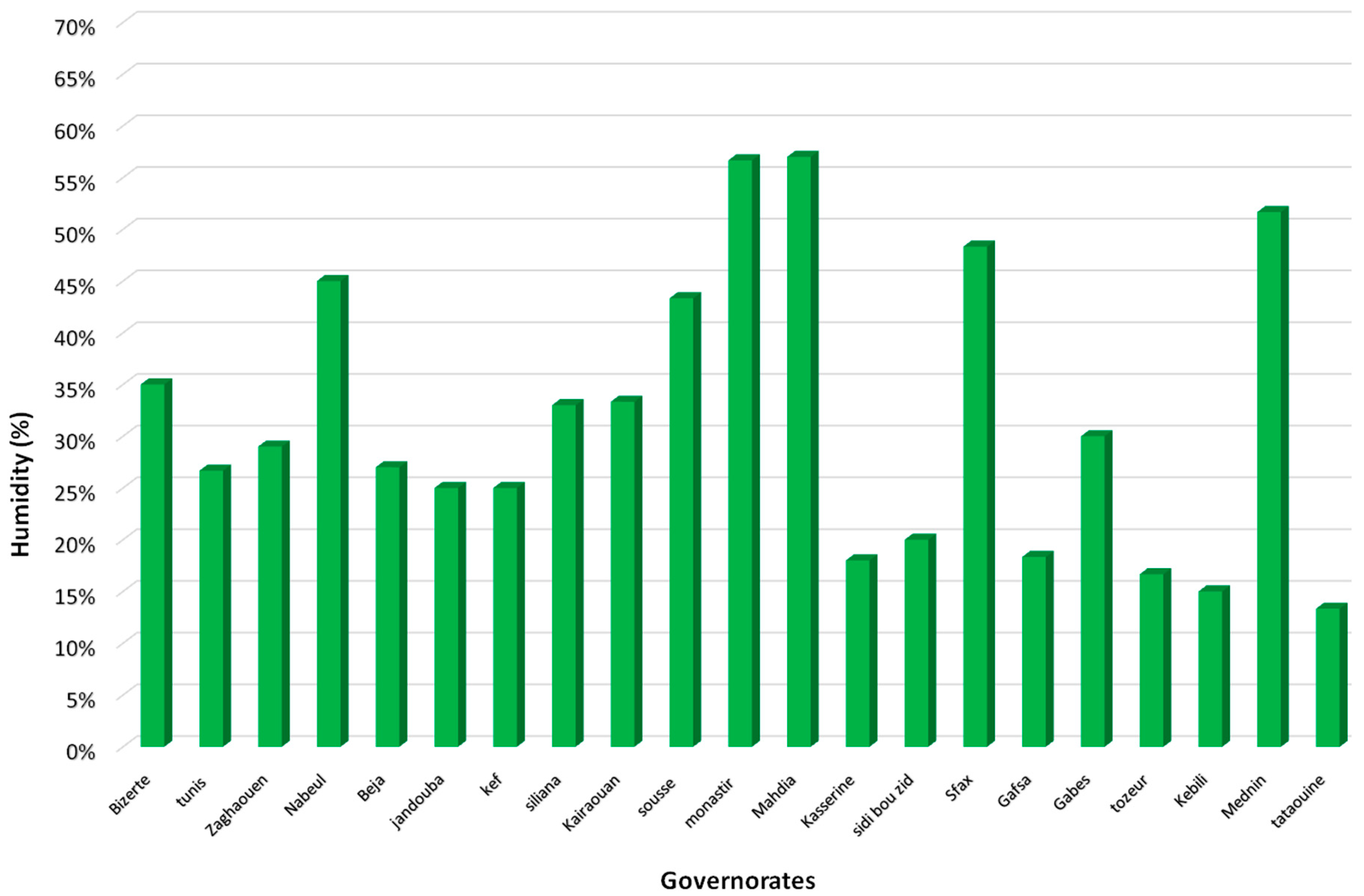
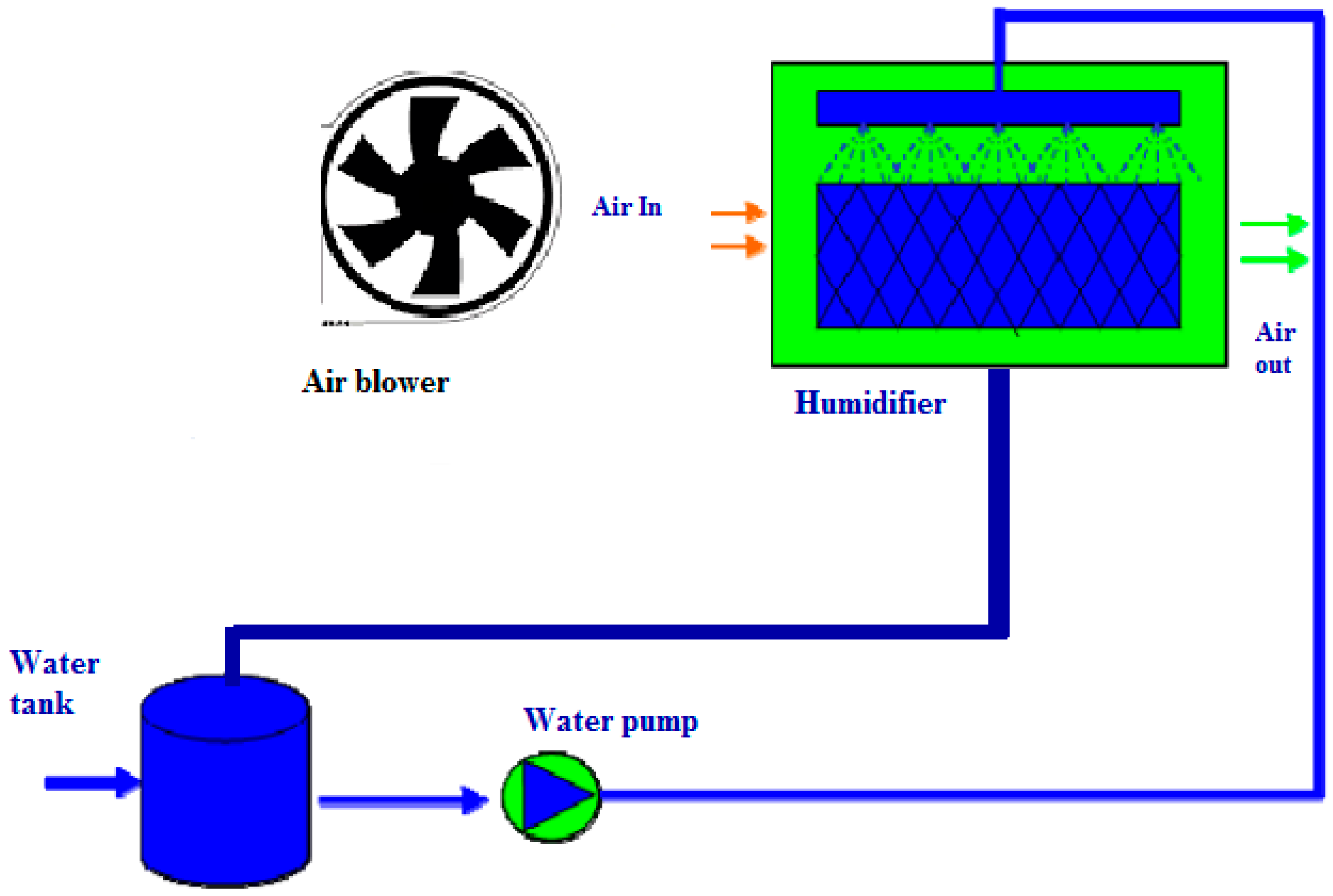


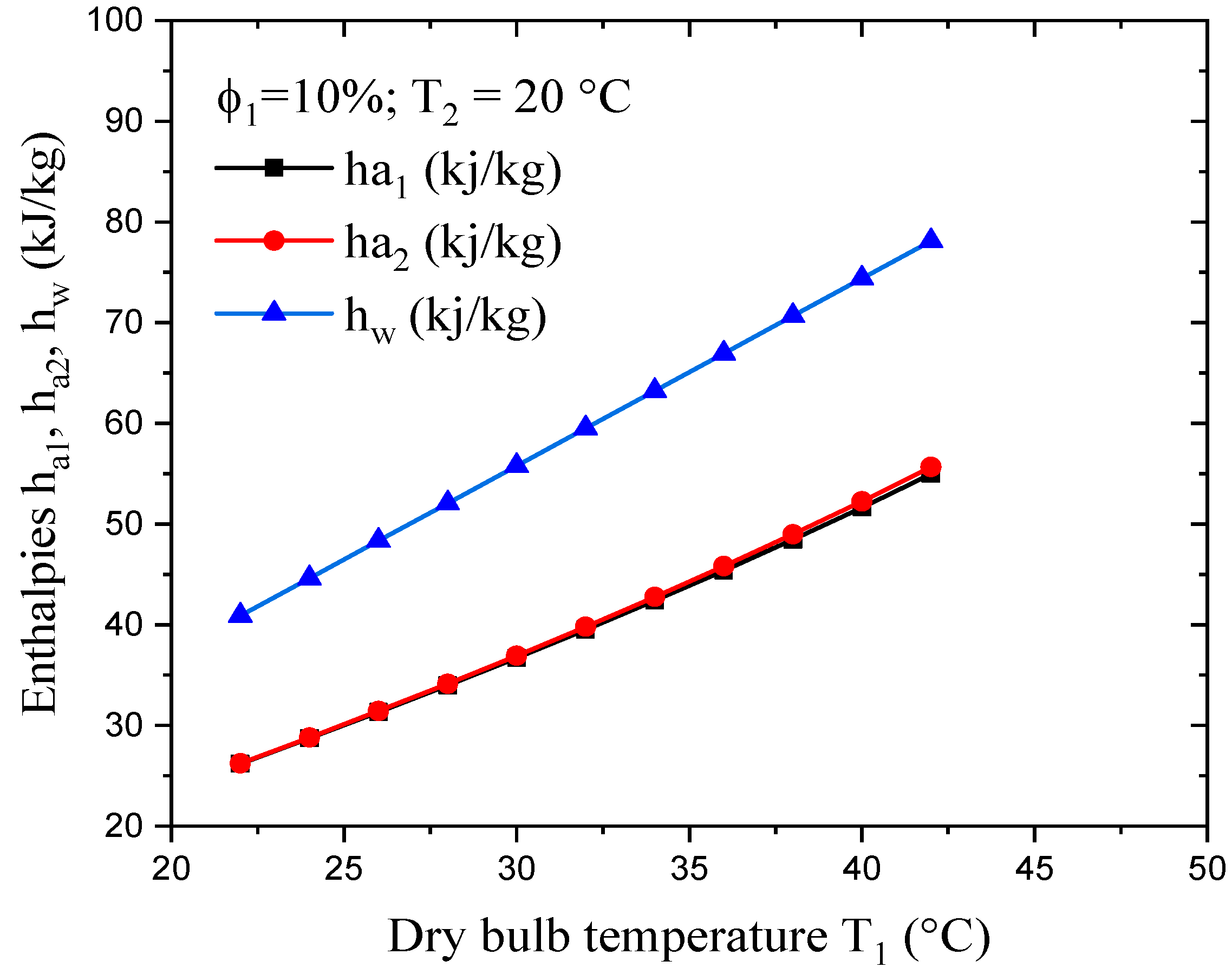
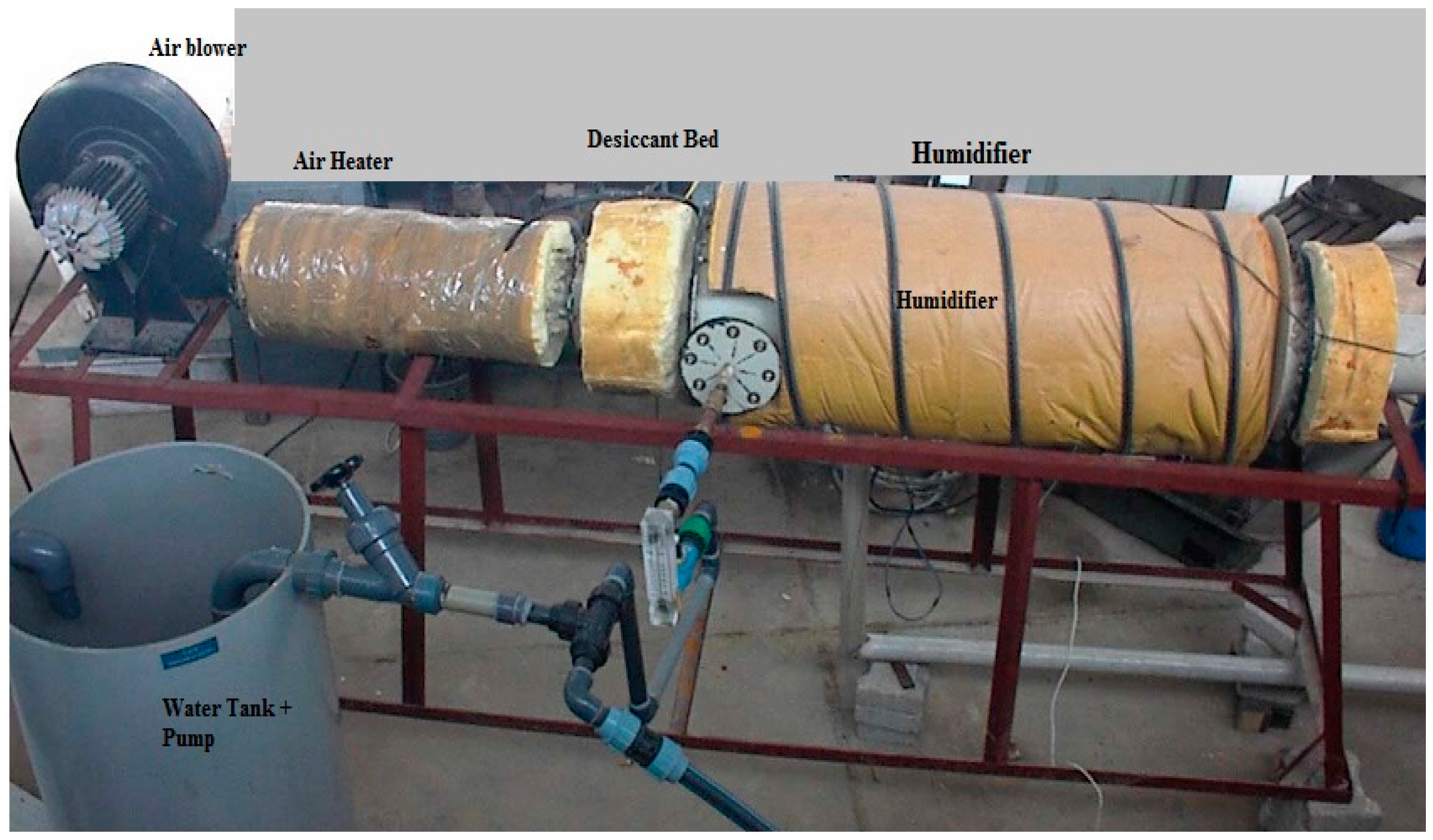
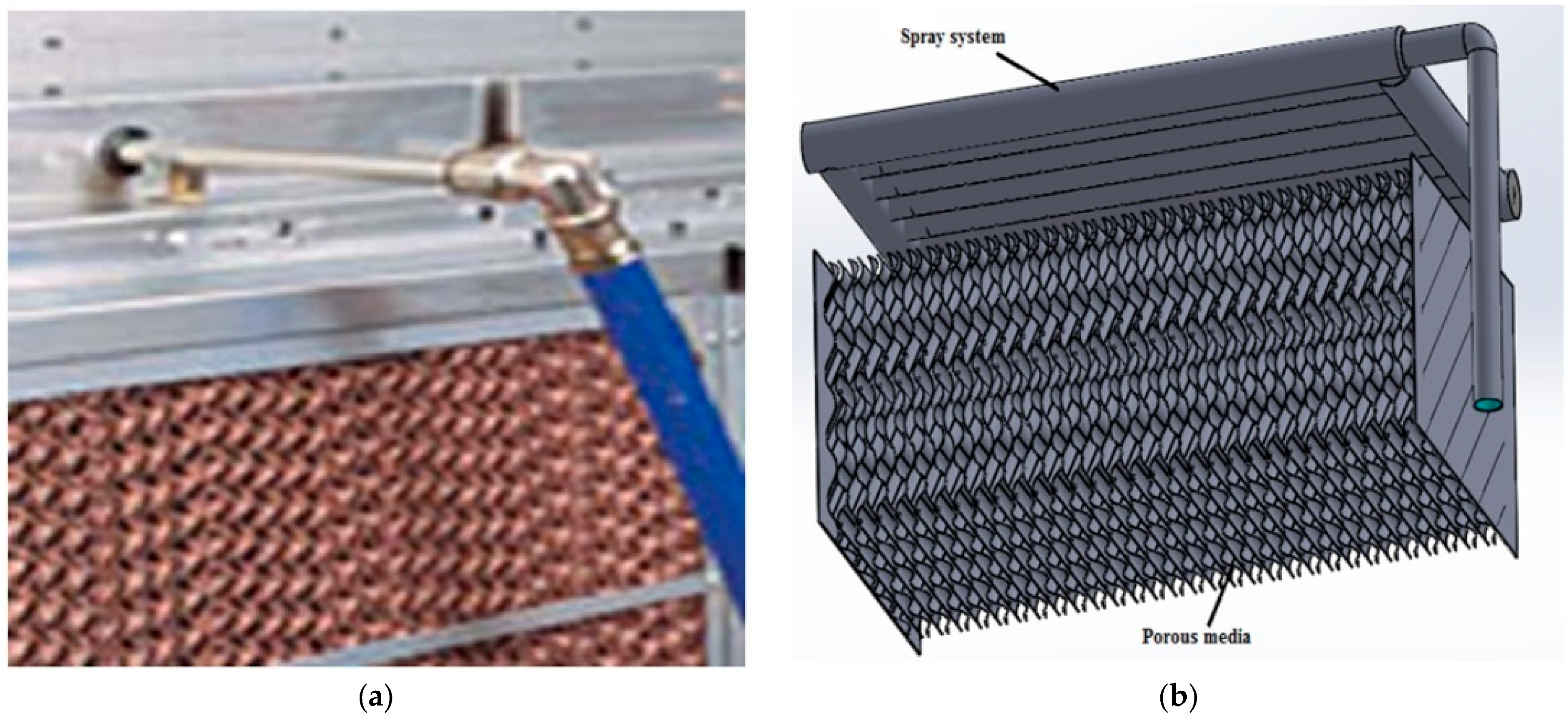
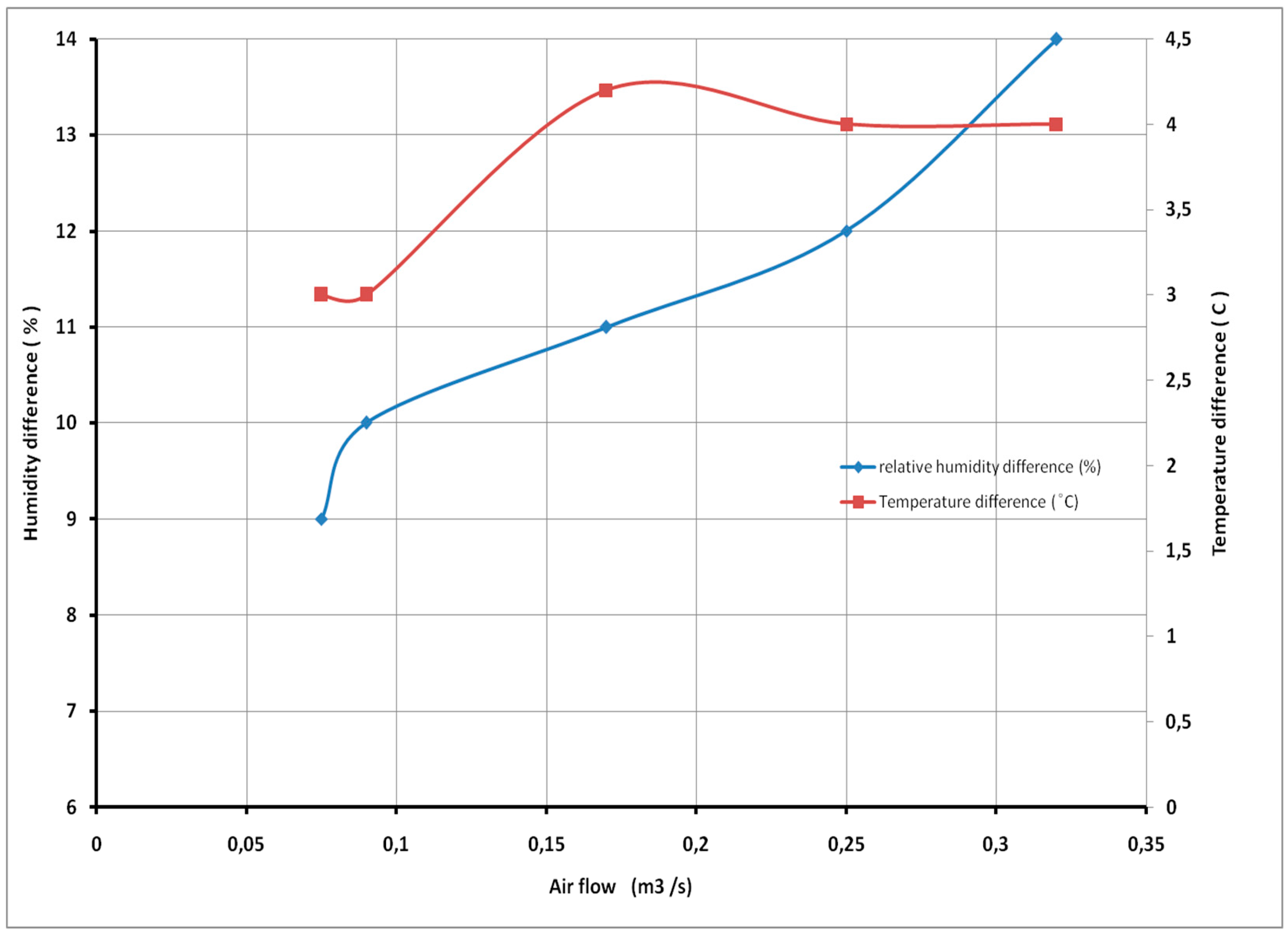
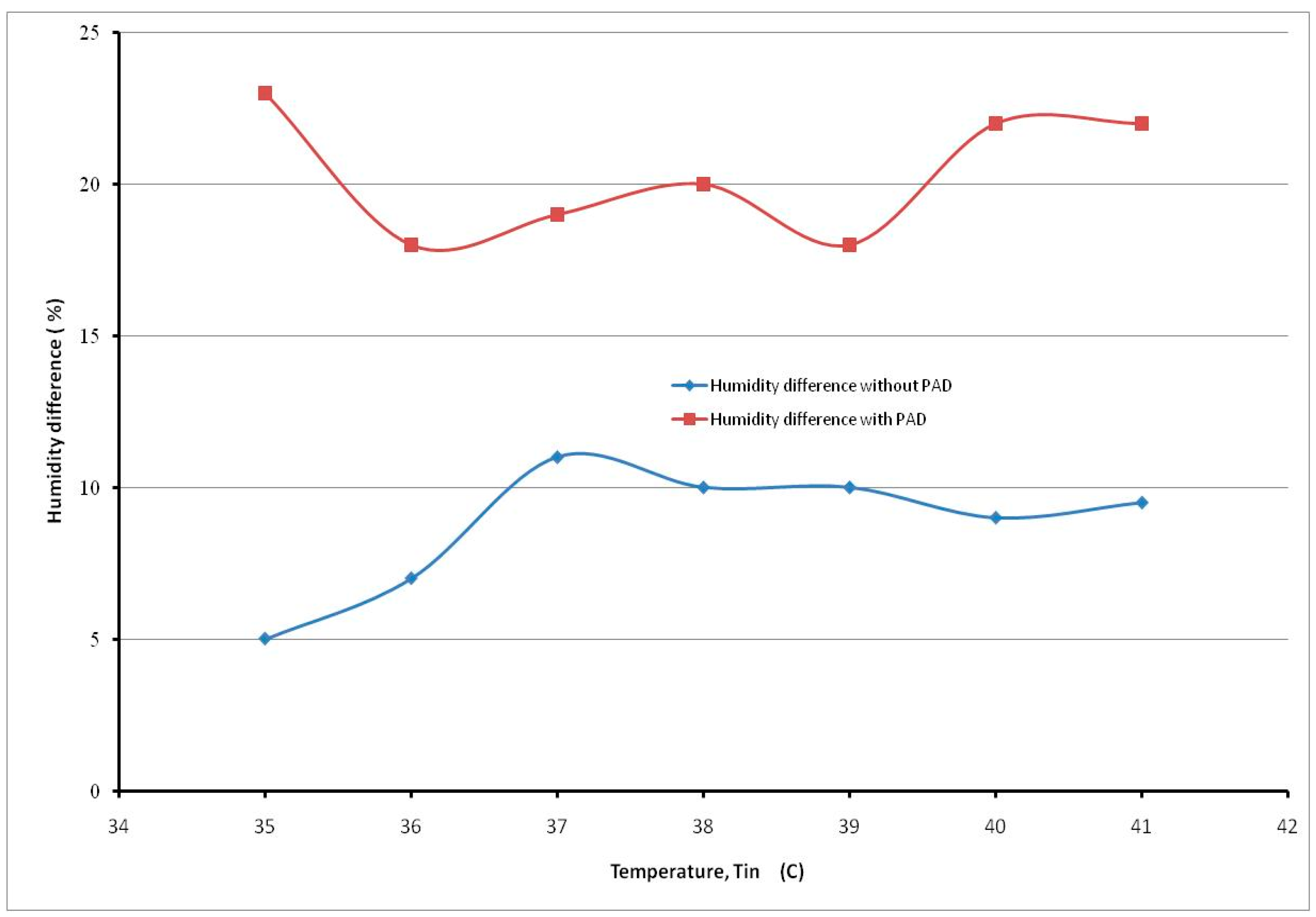
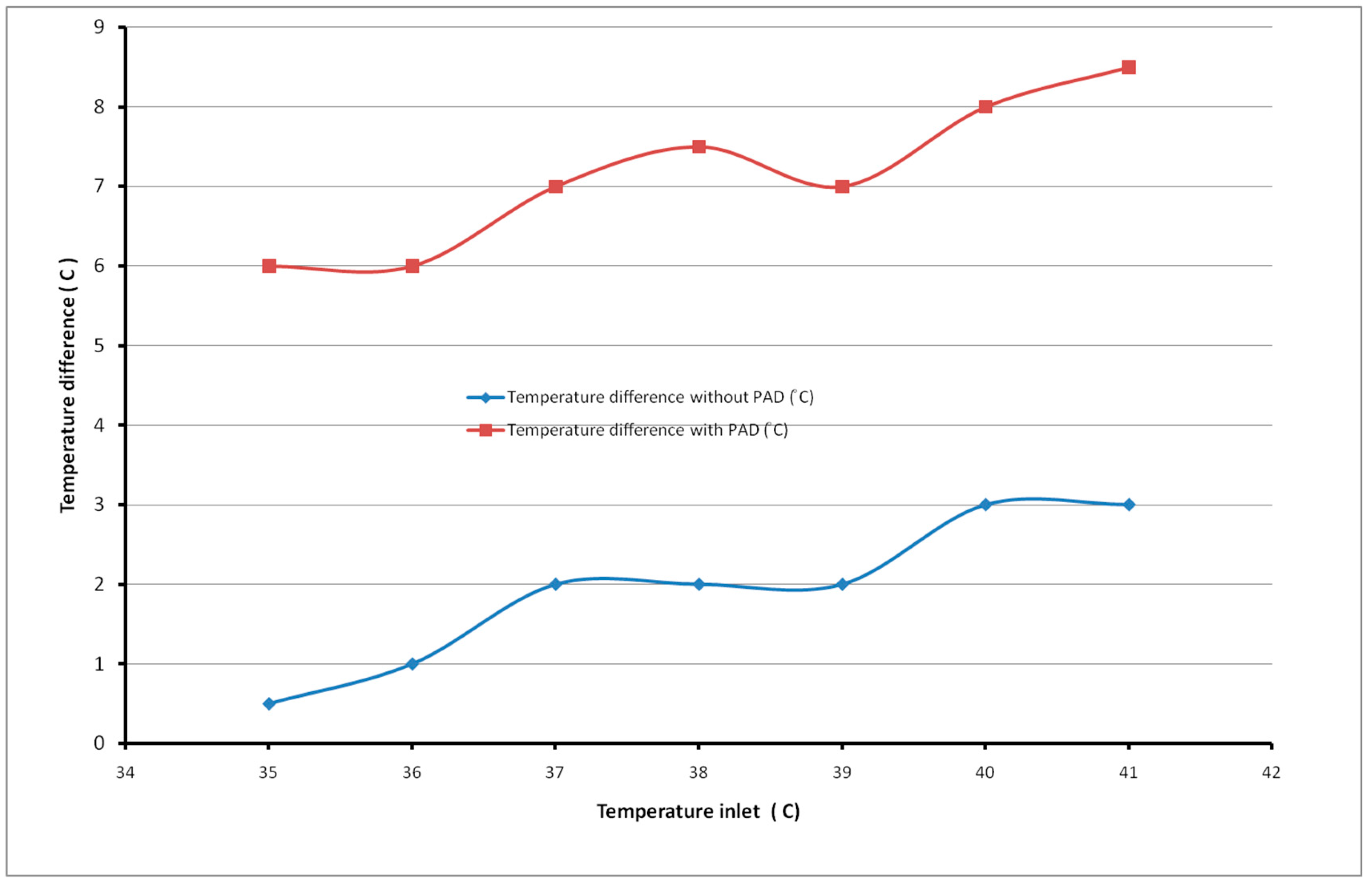

Disclaimer/Publisher’s Note: The statements, opinions and data contained in all publications are solely those of the individual author(s) and contributor(s) and not of MDPI and/or the editor(s). MDPI and/or the editor(s) disclaim responsibility for any injury to people or property resulting from any ideas, methods, instructions or products referred to in the content. |
© 2023 by the authors. Licensee MDPI, Basel, Switzerland. This article is an open access article distributed under the terms and conditions of the Creative Commons Attribution (CC BY) license (https://creativecommons.org/licenses/by/4.0/).
Share and Cite
Choubani, K.; Almeshaal, M.A.; Balghouthi, M.; Ben Rabha, M. Investigation of a Solar-Powered Evaporative Cooling System under Tunisian Climate. Coatings 2023, 13, 1901. https://doi.org/10.3390/coatings13111901
Choubani K, Almeshaal MA, Balghouthi M, Ben Rabha M. Investigation of a Solar-Powered Evaporative Cooling System under Tunisian Climate. Coatings. 2023; 13(11):1901. https://doi.org/10.3390/coatings13111901
Chicago/Turabian StyleChoubani, Karim, Mohammed A. Almeshaal, Moncef Balghouthi, and Mohamed Ben Rabha. 2023. "Investigation of a Solar-Powered Evaporative Cooling System under Tunisian Climate" Coatings 13, no. 11: 1901. https://doi.org/10.3390/coatings13111901
APA StyleChoubani, K., Almeshaal, M. A., Balghouthi, M., & Ben Rabha, M. (2023). Investigation of a Solar-Powered Evaporative Cooling System under Tunisian Climate. Coatings, 13(11), 1901. https://doi.org/10.3390/coatings13111901






